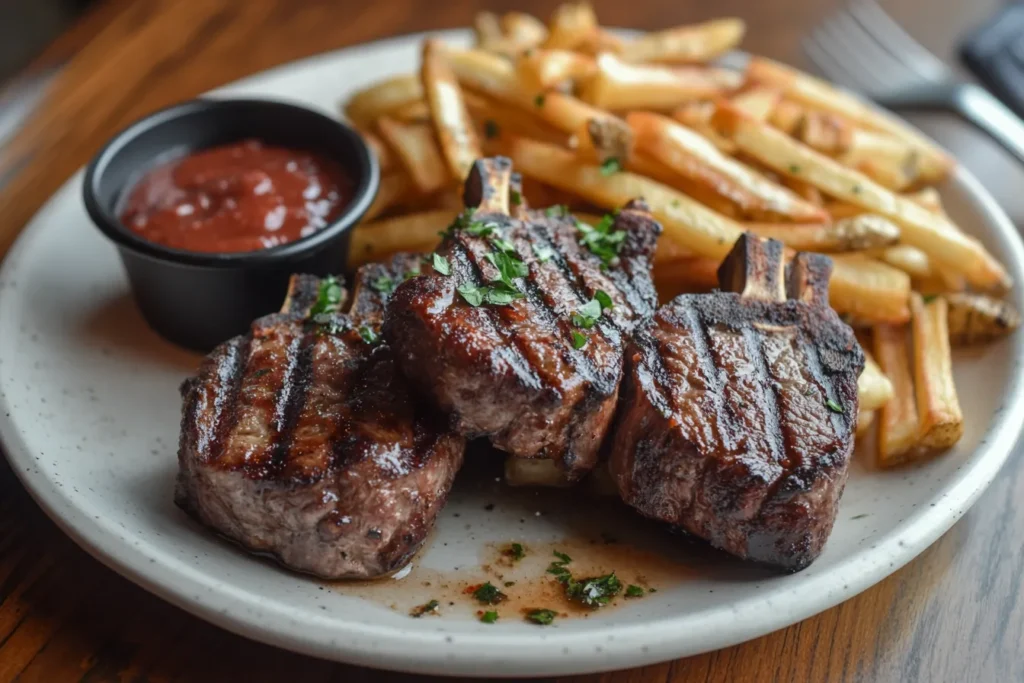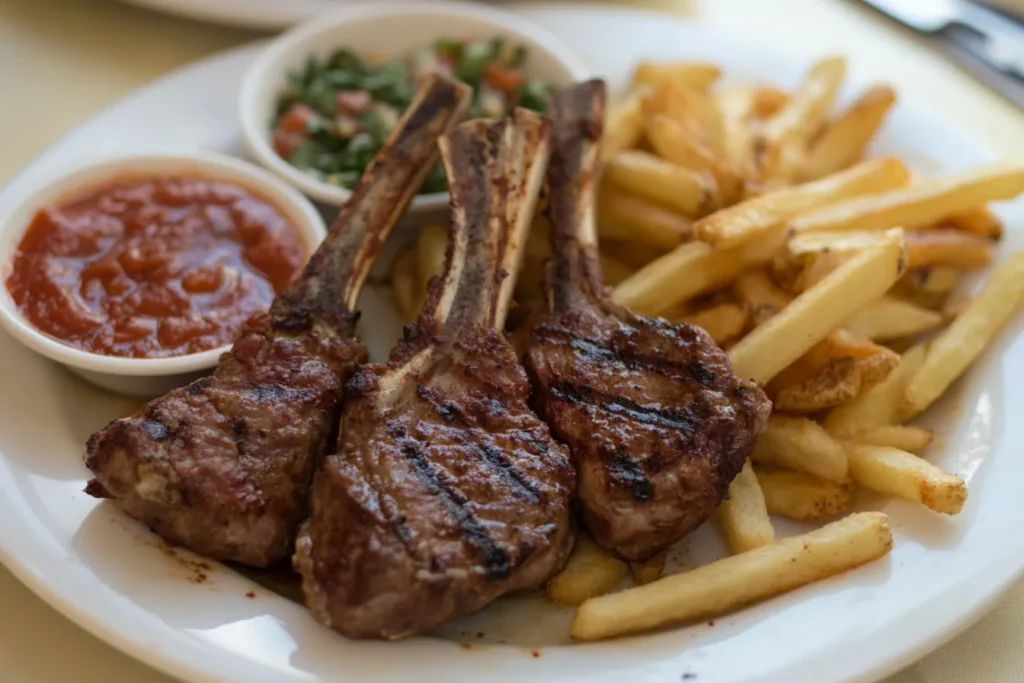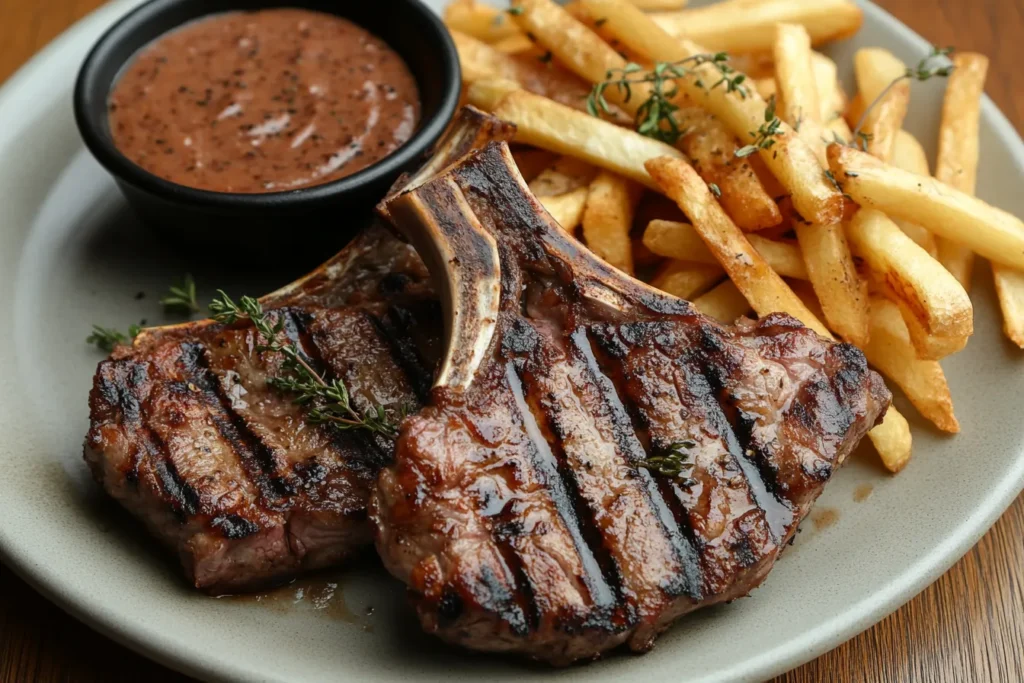Are you ready to elevate your cooking game with a dish that’s both simple and impressive? Lamb chops are the perfect answer to those who want a restaurant-quality meal without the fuss. Whether you’re hosting a dinner party or treating yourself to something special, mastering the art of cooking lamb chops can transform your culinary repertoire. Let’s dive into everything you need to know to prepare juicy, flavorful lamb chops that will make you the star of the kitchen!
List Of Contents
Introduction to Lamb Cuts
Lamb is a beloved meat enjoyed worldwide for its tenderness and rich flavor. However, not all lamb cuts are the same. Two of the most popular options are lamb chops and lamb shoulder chops. These cuts differ significantly in flavor, texture, and cooking techniques, which makes them suitable for different recipes and occasions. Whether you’re hosting a dinner party or preparing a weeknight meal, understanding these differences can help you make the right choice for your dish. Check out more recipes here.

Understanding Lamb Chops
Lamb chops are cut from the rib, loin, or rack sections of a lamb. They are prized for their tenderness, juiciness, and subtle flavor. Because they come from muscles that are not heavily worked, lamb chops are naturally tender. These cuts are often served in high-end restaurants and are synonymous with gourmet dining. Check out more recipes here.
Introduction to Lamb Shoulder Chops
In contrast, lamb shoulder chops come from the front shoulder of the lamb. They are known for their robust flavor and slightly tougher texture. Shoulder chops often contain more connective tissue and fat, which means they require longer cooking times to become tender. Despite this, they are a favorite for slow-cooked dishes where the flavors can develop beautifully over time. Check out more recipes here.
Why Different Cuts of Lamb Matter
When choosing between lamb chops and lamb shoulder chops, it’s important to consider how the cut affects the final dish. Every cut of lamb offers a unique combination of flavor and texture that pairs with specific cooking techniques and recipes. Check out more recipes here.
Flavor Profiles Across Lamb Cuts
Lamb chops are famous for their mild, slightly sweet taste. This makes them an excellent choice for those new to lamb or for recipes that rely on light seasoning. In contrast, lamb shoulder chops have a deeper, gamey flavor. Their fat content contributes to this richness, making them ideal for hearty stews and slow roasts.
For example, in Mediterranean cuisine, lamb shoulder chops are commonly used in recipes with bold spices, while lamb chops shine in dishes where simple herbs like rosemary and thyme are used. Check out more recipes here.
Nutritional Value of Lamb Chops vs. Shoulder Chops
The lamb is a nutrient-dense protein, but the nutritional profiles of lamb chops and lamb shoulder chops vary due to differences in fat content and muscle composition.
Overview of Nutritional Content
The Lamb chops are leaner compared to shoulder chops. A typical serving contains fewer calories and less fat, which makes it appealing for those watching their calorie intake. On the other hand, the lamb shoulder chops are richer in healthy fats, providing a higher calorie count and a more satisfying meal.
Health Benefits of Each Cut
Both cuts are excellent sources of essential nutrients such as:
- Protein for muscle repair.
- Zinc for immune function.
- Iron for energy and oxygen transport.
Shoulder chops, with their higher fat content, can provide more energy and are great for athletes or individuals with high caloric needs. Meanwhile, lamb chops are better suited for lighter meals without compromising on nutritional value.
Culinary Uses of Lamb in Different Cultures
Lamb is a staple in many cuisines, and the type of lamb cut often dictates how it is prepared.
Role of Chops in Global Cuisines
- Lamb Chops: In French cuisine, lamb chops are often prepared as lamb cutlets, paired with delicate sauces and fine wines. In the U.S., grilled lamb chops with garlic and rosemary are a backyard favorite.
- Lamb Shoulder Chops: Middle Eastern and Indian cuisines often feature lamb shoulder chops in slow-cooked dishes like curries and stews. The robust flavor of shoulder chops stands up well to bold spices like cumin, turmeric, and cinnamon.
Anatomy of the Cuts: Lamb Chops vs. Shoulder Chops
The anatomy of lamb cuts plays a crucial role in their culinary characteristics. Understanding where each cut comes from helps explain their differences in flavor, texture, and cooking methods.
Location of Lamb Chops
Lamb chops are sourced from the rib, loin, or rack sections of the lamb. These areas consist of tender muscles that do minimal work during the animal’s life. Due to this, lamb chops have a soft, melt-in-your-mouth texture. Specific cuts include:
- Rib Chops: Known for their small size and characteristic rib bone, rib chops are among the most tender cuts of lamb.
- Loin Chops: These chops resemble small T-bone steaks and are slightly meatier than rib chops.
- Rack of Lamb: When multiple rib chops are left together, they form a rack of lamb, perfect for roasting and elegant presentations.
Location of Lamb Shoulder Chops

Lamb shoulder chops come from the front shoulder portion of the lamb. These muscles are more heavily worked, resulting in a firmer texture. Additionally, shoulder chops often contain bones, connective tissue, and layers of fat, which all contribute to their flavor.
- Shoulder Blade Chops: These are cut closer to the spine and tend to have a mix of bone and fat.
- Arm Chops: Taken from the front leg area, these are slightly leaner but still retain the signature gamey flavor.
Texture Differences
The texture of lamb chops and shoulder chops directly affects how they are cooked and enjoyed.
Tenderness of Lamb Chops
Lamb chops are highly tender due to their lean meat and minimal connective tissue. They can be quickly cooked using methods like grilling or pan-searing. When prepared correctly, they deliver a juicy and delicate eating experience.
Chewier Nature of Shoulder Chops
Shoulder chops, on the other hand, are firmer and can be chewy if not cooked properly. However, their connective tissue breaks down during slow cooking, transforming the meat into a tender and flavorful delight. This makes them ideal for dishes like braised lamb or stews.
Mild Flavor of Lamb Chops
The mild flavor of lamb chops is subtle and pairs well with light seasoning. This allows the natural taste of the meat to shine through. For example:
- Grilled lamb chops with lemon and herbs highlight their delicate taste.
- Lamb cutlets with a mint glaze are another classic pairing.
Rich and Gamey Flavor of Shoulder Chops
In contrast, shoulder chops have a robust, gamey flavor due to their higher fat content. This makes them perfect for recipes that feature bold flavors and long cooking times. Think:
- Lamb curry with a blend of spices.
- Slow-cooked lamb stew with red wine and root vegetables.
Cost Comparison
When considering lamb cuts, cost is another factor to weigh. Lamb shoulder chops are generally more affordable than lamb chops due to their tougher texture and larger size. This makes shoulder chops a budget-friendly option for hearty meals.
Availability in Markets
The availability of lamb chops and shoulder chops often depends on the season and region.
- Lamb Chops: These are widely available year-round and are commonly found in premium grocery stores and butcher shops. However, they may be pricier during peak demand periods, such as holidays.
- Shoulder Chops: While equally available, shoulder chops are often more prominent in local butchers and ethnic markets, where slow-cooked recipes are popular.
Culinary Uses and Pairings
The best way to enjoy lamb chops and shoulder chops is to match them with appropriate sides, wines, and flavors.

Complementary Pairings for Each Cut
- Lamb Chops: Pair with lighter sides like roasted asparagus or a fresh salad. Wines such as Pinot Noir or Sauvignon Blanc complement their mild flavor.
- Shoulder Chops: Rich sides like creamy mashed potatoes or polenta work beautifully. For wine, opt for bold reds like Shiraz or Malbec to match their gamey taste.
Cooking Techniques for Lamb Chops and Shoulder Chops
The way you cook lamb chops or shoulder chops dramatically affects the flavor and texture. Choosing the right method ensures the best results, whether you’re grilling for a quick dinner or slow-cooking for a rich stew.
Best Methods for Lamb Chops
Lamb chops are prized for their tenderness, so quick and high-heat cooking methods work best.
- Grilling: This is one of the most popular methods. Lamb chops cook beautifully over a hot grill, acquiring a smoky char that enhances their mild flavor. A marinade with olive oil, garlic, and rosemary elevates the dish.
- Pan-Seared Techniques: A hot skillet with a touch of butter or oil quickly sears lamb chops, locking in their juices. Adding herbs and a splash of wine during the final minutes of cooking creates a simple yet sophisticated meal.
- Broiling: For an indoor alternative to grilling, broiling lamb chops in the oven achieves similar results. A quick rub with spices like paprika and thyme brings out the best in this cut.
Best Methods for Shoulder Chops
Lamb shoulder chops benefit from low-and-slow cooking methods, which break down their connective tissue and deepen their flavor.
- Braising: A classic choice for shoulder chops. Braising involves simmering the meat in liquid, such as broth or wine, over a low flame or in the oven. This method tenderizes the meat and infuses it with the flavors of the cooking liquid.
- Slow Cooking: Shoulder chops are perfect for crockpot recipes. Combine them with vegetables, aromatic spices, and a flavorful sauce for a fuss-free meal that tastes like it took hours of effort.
- Roasting: While less common, slow-roasting shoulder chops at a low temperature can yield tender results, especially when combined with hearty root vegetables.
Cost Comparison
Cost often influences the decision between lamb chops and shoulder chops.
- Why Shoulder Chops Are More Affordable: Shoulder chops are less expensive because they require more preparation and longer cooking times. Their tougher texture and higher fat content also make them less in demand compared to tender lamb chops.
- Value for Money: Despite their lower cost, shoulder chops offer rich flavor, making them a great choice for budget-conscious cooks who want maximum taste.
Availability in Markets
Seasonal and regional factors can influence how readily you can find lamb chops or shoulder chops.
- Seasonality: Spring lamb is most common in markets from March to June, with an abundance of all cuts. Outside these months, availability may decrease, and prices can rise.
- Regional Availability: In areas with a strong tradition of lamb-based dishes, such as the Mediterranean or Middle East, both cuts are widely available. Specialty butchers often carry a broader selection than chain supermarkets.
Pairing Lamb Chops and Shoulder Chops with Wine and Sides
A well-paired wine or side dish enhances the experience of eating lamb, complementing its unique flavor profiles.
Lamb Chops Pairings
- Wine: Light to medium-bodied wines like Pinot Noir or Chardonnay balance the mildness of lamb chops. A squeeze of lemon or a mint-based sauce adds freshness to the dish.
- Sides: Roasted seasonal vegetables, couscous with herbs, or a vibrant arugula salad are excellent choices.
Shoulder Chops Pairings
- Wine: The richness of shoulder chops pairs well with bold red wines like Cabernet Sauvignon or Syrah. These wines cut through the fat and enhance the robust flavors.
- Sides: Creamy mashed potatoes, garlic-infused polenta, or a hearty ratatouille complement the depth of shoulder chops.
Conclusion: Choosing the Right Cut for the Right Meal
When deciding between lamb chops and lamb shoulder chops, the key is to consider your culinary goals and preferences.
Summary of Key Differences
- Lamb Chops: Ideal for quick cooking, tender, and mild in flavor. Perfect for grilled dishes or elegant dinner plates.
- Shoulder Chops: Rich, gamey, and suitable for slow cooking. Great for hearty meals and dishes that require bold flavors.
Recommendations Based on Preferences
- If you prefer tender meat with a mild taste and minimal prep, lamb chops are the way to go.
- If you enjoy robust, complex flavors and have time for slow cooking, shoulder chops are the perfect choice.
FAQs
1. What is the ideal way to prepare lamb chops?
Grilling or pan-searing lamb chops over high heat ensures a tender and flavorful result.
2. Can lamb shoulder chops be grilled?
Yes, but they must be marinated and cooked slowly to avoid toughness.
3. Are lamb chops healthier than shoulder chops?
Lamb chops are leaner and contain fewer calories, making them a slightly healthier choice.
4. What spices work well with lamb shoulder chops?
Bold spices like cumin, paprika, and coriander enhance the flavor of lamb shoulder chops.
5. How do I know when lamb chops are cooked?
Use a meat thermometer. Medium-rare lamb chops should register at 145°F (63°C).
6. Why are lamb chops more expensive than shoulder chops?
Lamb chops come from tender parts of the lamb, making them more desirable and pricier.
7. Can lamb shoulder chops be used for kebabs?
Yes, if they are properly marinated and trimmed of excess fat.
8. How long should I braise lamb shoulder chops?
Typically, 1.5 to 2 hours at a low simmer yields the best results.
9. Are lamb chops good for meal prep?
Yes, as they cook quickly and can be paired with various sides.
10. What sides pair best with shoulder chops?
Rich, starchy sides like mashed potatoes or roasted root vegetables complement their flavor.
